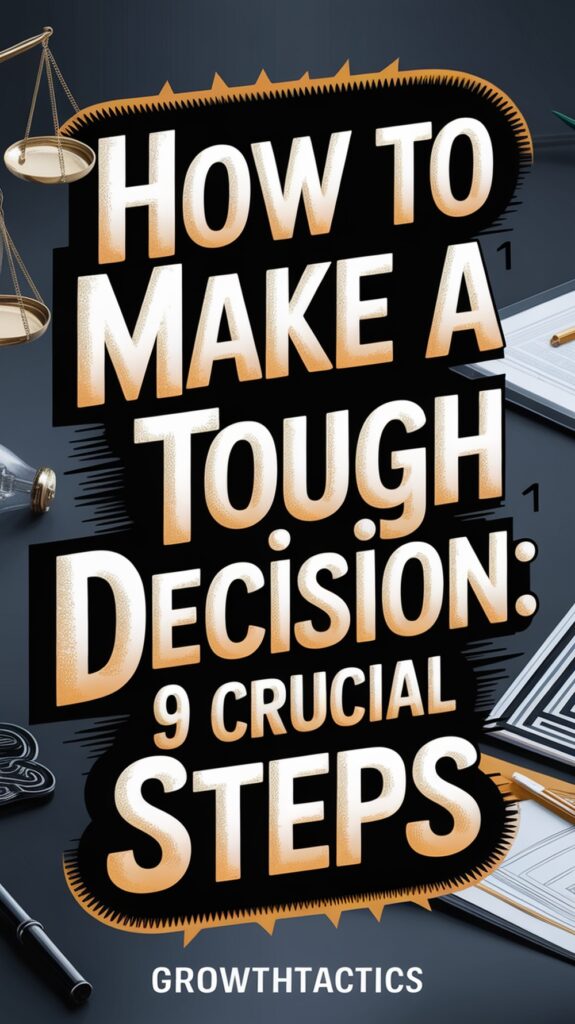Life throws tough choices at us all the time. I’ve been there, staring at a big decision, feeling stuck.
Instead of letting big decisions stress you out, understand you’ve got the power to make good choices, even when it’s hard.
In this article, I’ll share 9 steps on how to make a tough decision. Remember, there’s no one-size-fits-all approach. You’re unique, and your decision-making process can be too.
Whether you’re choosing a new job, moving to a new city, or making a life-changing choice, these steps will help you find your way. So, let’s roll up our sleeves and tackle this together.
Jump To Section
Step 1: Define Your Purpose
When you’re facing a tough decision, it’s easy to get lost in the details. But here’s a secret I’ve learned: start with your purpose.
Why? Because knowing why you’re making this choice can light the way forward.
I always ask myself, “What am I trying to achieve here?” It’s like setting a destination before starting a journey. Your purpose is your North Star, guiding you when the path gets foggy.
Think about it. Are you trying to grow in your career? Improve your relationships? Or maybe find more happiness in your daily life? Whatever it is, name it. Write it down if that helps.
Here’s a tip: if you’re stuck, try asking yourself how you want to feel after making this decision. Relieved? Excited? Proud? These feelings can point you towards your true purpose.
So, take a deep breath. Pause for a moment. Ask yourself, “What really matters to me in this decision?” Trust me, once you have that answer, the next steps become a whole lot clearer.
Step 2: Gather Information
Before you jump into a tough decision, it’s smart to arm yourself with knowledge. I’ve learned that good information can make a world of difference.
Start by asking yourself, “What do I need to know?” Make a list of questions. Don’t be shy, no question is too small when it comes to big decisions.
Now, where can you find answers? I like to use a mix of sources:
- Talk to people who’ve been there. Their experience is gold.
- Look online, but be picky about your sources. Not everything on the internet is true!
- Read books or articles from experts in the field.
- If it’s a work decision, check company policies or talk to HR.
Remember, you don’t need to know everything. Just focus on what matters most to your decision.
Simple Exercise for Finding Information
Let’s try a quick exercise to jumpstart your information hunt. I use this all the time, and it really helps!
- Grab a piece of paper or open a notes app on your phone.
- At the top, write down your tough decision in one sentence.
- Now, draw three columns:
-
- Column 1: “What I Know”
- Column 2: “What I Need to Know”
- Column 3: “Where to Find It”
- Give yourself 5 minutes to fill in as much as you can.
- For the “Where to Find It” column, get creative! Think about friends, experts, websites, or books that could help.
This exercise helps you see what you already know and what you still need to learn. It’s like creating a roadmap for your research.
I’ve found that this simple step can make the whole process feel less overwhelming. Plus, it gives you a clear starting point.
Step 3: List Your Options
Now that you’ve gathered information, it’s time to lay out your choices. I always find this step exciting because it shows me what’s possible.
Write down every option you can think of. Don’t judge your ideas yet, just let them flow.
I like to ask myself, “What would I do if I had no limits?” This often leads to creative solutions I might have missed otherwise.
Here’s a tip: include the option of doing nothing. Sometimes, that’s a valid choice too!
Don’t worry if your list feels short or long. Quality matters more than quantity. I’ve made great decisions with just two options, and I’ve also needed ten to find the right path.
If you’re stuck, try these tricks:
- Ask a friend for ideas
- Think about what someone you admire would do
- Imagine advising a friend in your situation
Take your time with this step. Sleep on it if you need to. New options might pop up when you least expect them.
Listing your options isn’t about finding the perfect solution right away. It’s about opening your mind to possibilities. Trust me, this sets you up for success in the next steps of your decision-making journey.
Remember, you’re not committing to anything yet. You’re just exploring. So have fun with it!
Step 4: Weigh the Pros and Cons
Alright, you’ve got your options laid out. Now it’s time to dig deeper. This is where things get real, and I’ve found it’s often the most eye-opening part of making decisions.
Let’s break it down:
- Look at each option on your list.
- Ask yourself these questions:
- What are the good things that could happen?
- What problems might come up?
- How will this affect me soon?
- What about later on?
Don’t rush. Take your time to really picture what might happen.
I always write down my thoughts for each option. It helps me see things more clearly.
Remember, you’re not a fortune teller. You can’t know for sure what will happen. But thinking about possible outcomes helps you make smarter choices.
It’s okay to feel nervous when thinking about consequences. Big decisions can be scary. But facing those fears now can save you from bigger worries later.
Don’t forget to think about how your choices might affect others. Our decisions often touch the lives of people around us.
As you go through this step, you might find that some options no longer feel right. That’s okay! It’s all part of the process.
Step 5: Listen to Your Gut While Making Decisions
Now that you’ve thought through your options, it’s time to tune into your inner voice. I call this the “gut check” step, and it’s one of my favorites.
Your gut feeling is like a secret superpower. It’s your inner wisdom talking to you. Sometimes, it whispers. Other times, it shouts. Either way, it’s worth listening to.
Here’s how I do a gut check:
- Find a quiet spot where you won’t be bothered.
- Close your eyes and take a few deep breaths.
- Think about each of your options, one at a time.
- Pay attention to how your body feels with each choice.
Do you feel excited? Scared? Peaceful? There’s no right or wrong feeling. What matters is that you notice it.
I’ve learned that our bodies often know things before our minds do. That knot in your stomach or that spark of excitement? That’s valuable information.
But here’s the thing: listening to your gut doesn’t mean ignoring facts. It means balancing what you know with what you feel.
Sometimes, your gut might disagree with what looks good on paper. When that happens, dig deeper. Ask yourself why you’re feeling that way.
Listening to your gut isn’t about finding the “perfect” choice. It’s about finding the choice that feels right for you, right now.
Step 6: Seek Outside Advice on Your Tough Decision
Now that you’ve done some deep thinking on your own, it’s time to bring in other perspectives. I always say two heads are better than one, and in this case, more heads can be even better!
Asking for advice doesn’t mean you’re not capable. It means you’re smart enough to know that others might see things you don’t.
Here’s how I approach getting outside advice:
- Make a list of people you trust and respect.
- Choose a mix of people, some who know you well, others who might offer a fresh view.
- Explain your situation clearly.
- Ask for their honest thoughts.
Remember, you’re not asking them to decide for you. You’re just gathering more information.
I’ve found that sometimes, just talking through my options with someone else helps me see things more clearly.
Don’t be afraid to ask experts, too. Talking to a professional can be helpful if your decision involves something specific, like finances or health.
But here’s the important part: listen to advice, but don’t feel like you have to follow it. You’re the one who knows your situation best.
So reach out, listen up, and see what new insights you can gather. You might be surprised at what you learn!
Step 7: Set a Deadline to Make Your Decision
Okay, we’ve done a lot of thinking and talking. Now it’s time to put a pin in it. Setting a deadline is crucial, and I’ll tell you why.
Without a deadline, we can get stuck in what I call “decision limbo.” That’s not a fun place to be!
Here’s how I approach setting a decision deadline:
- Look at your situation. How urgent is it?
- Give yourself enough time to think, but not so much that you overthink.
- Mark the deadline on your calendar or set a reminder on your phone.
- Tell someone about your deadline. It helps keep you accountable.
Remember, the goal isn’t to rush. It’s to keep moving forward.
I’ve found that having a deadline helps me focus. It gives me a sense of purpose and keeps me from dragging my feet.
Sometimes, we avoid deciding because we’re afraid of making the wrong choice. But here’s a secret: there’s rarely a perfect decision. There’s just the best decision you can make with what you know right now.
Step 8: Make Your Decision and Stick to It
Alright, this is it. Decision time. You’ve done the work, and now it’s time to trust yourself.
I know making the final call can feel scary. But remember, you’re ready for this.
Here’s how I approach making and sticking to a decision:
- Take a deep breath. Center yourself.
- Review your notes one last time.
- Make your choice. Say it out loud if it helps.
- Write down your decision and why you made it.
Now, here’s the important part: once you decide, commit to it.
I’ve learned that second-guessing yourself only leads to stress. Trust that you made the best choice with the information you had.
And if your decision doesn’t work out, focus on how to fix it and don’t get stuck regretting making the wrong call.
Step 9: Reflect and Learn
Okay, you’ve made your decision. But we’re not done yet. This last step is super important, and I never skip it.
It’s time to reflect and learn from your decision-making process.
Here’s what I do:
- I take a few minutes to think about how I made my choice.
- I ask myself what went well and what I could do better next time.
- I write down my thoughts. It helps me remember for future decisions.
Learning from your decisions is how you grow. It’s how you become a better decision-maker.
Did you rush and wish you’d taken more time? Or did you overthink things?
Maybe you listened to others too much. Or not enough.
Whatever happened, there’s always something to learn.
I’ve made plenty of mistakes in my decisions. But each one taught me something valuable.
The more you practice, the better you’ll get at making choices that work for you.


